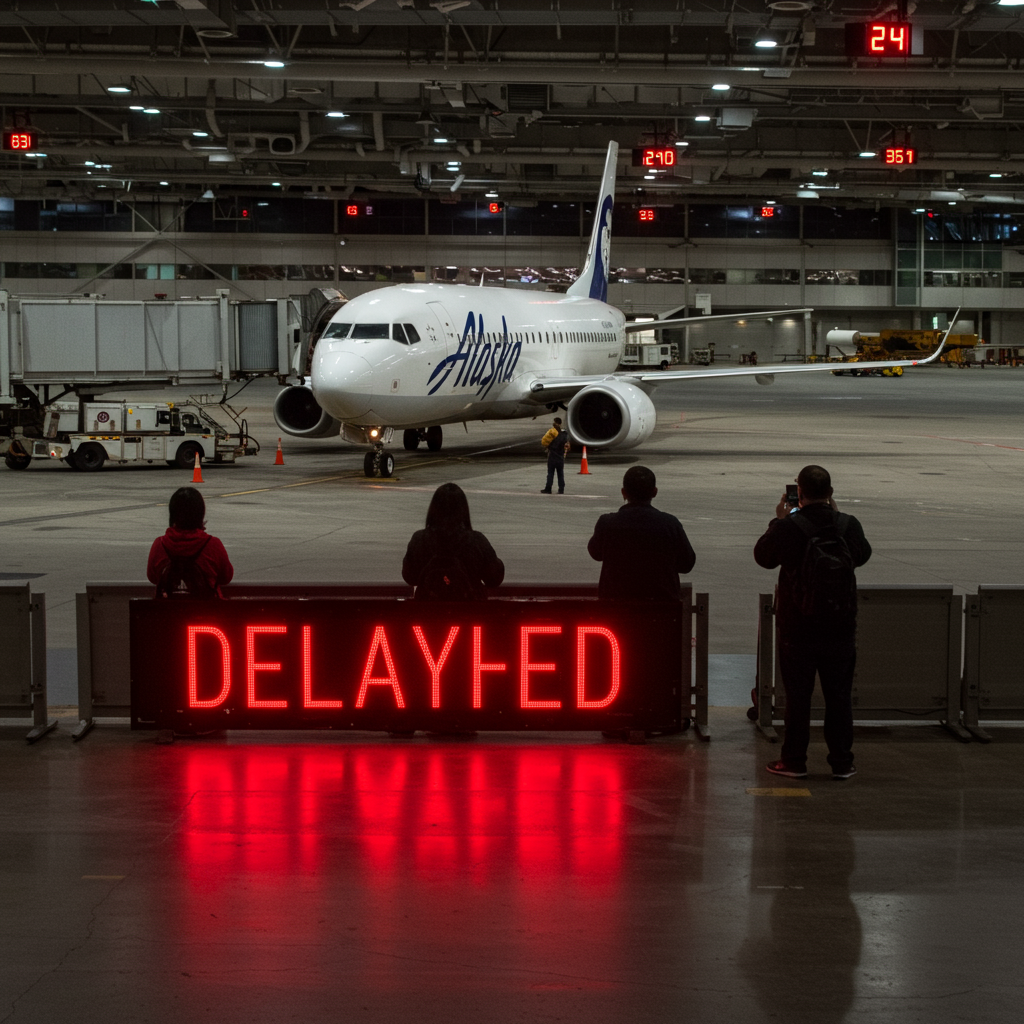A sudden and severe IT failure recently plunged Alaska Airlines into operational chaos. This critical Alaska Airlines IT outage triggered a system-wide ground stop, disrupting thousands of travelers. While resolved quickly, the incident’s ripple effects caused extensive flight cancellations and delays. The airline is actively working to restore normal operations across its network. Passengers faced significant inconvenience due to these unforeseen circumstances.
The Unforeseen Halt: How a Hardware Failure Grounded Flights
Late Sunday evening, an unexpected hardware failure at an Alaska Airlines data center initiated widespread disruption. This critical component, supplied by a third-party vendor, affected several key operational systems. Despite featuring supposed “multi-redundant” safeguards, the system failed. This necessitated an urgent, system-wide ground stop for all Alaska Airlines and Horizon Air flights.
The grounding began around 8 p.m. Pacific Time on Sunday, July 20. It aimed to keep aircraft safely positioned while technicians addressed the core issue. Within approximately three hours, by 11 p.m. PT, the primary IT problem was resolved. Flight operations officially resumed, but the immediate impact was already significant. This quick fix, however, did not prevent lingering issues.
Widespread Ripple Effects: Flight Cancellations and Delays Persist
The brief Sunday night ground stop had a cascading effect into Monday morning. Data from FlightAware confirmed substantial flight disruptions. On Monday, 66 Alaska Airlines flights were canceled, representing 7% of its scheduled departures. An additional 110 flights, or 12%, experienced delays by 10:45 a.m. ET.
Horizon Air, Alaska’s regional subsidiary, also grappled with service interruptions. Overall, the airline reported over 150 flight cancellations since Sunday evening. Seattle-Tacoma International Airport (Sea-Tac) bore a significant portion of these impacts. By Monday mid-morning, Sea-Tac alone saw 64 Alaska Airlines cancellations and 137 delays. Horizon Air registered four cancellations and one delay at the busy hub.
Beyond the Fix: Why Disruptions Linger for Air Travel
Even after resolving the technical glitch, airlines face a complex recovery process. The initial ground stop created an immediate imbalance in aircraft and crew positioning. Planes were stuck in the wrong locations across the network. Crews were out of sequence with their scheduled flights.
Alaska Airlines acknowledged these “residual impacts.” They warned passengers that “additional flight disruptions are likely.” This is necessary to reposition aircraft and crews throughout their network. The logistics of normalizing airline operations after a system-wide halt are immense. It demands careful planning and execution over many hours.
Alaska Airlines’ Response and Passenger Reassurance
Alaska Airlines moved swiftly to communicate with affected passengers. Initially, they cited a general “IT issue” via social media. Later, the airline clarified the root cause: an “unexpected failure of a critical piece of hardware.” This hardware was at its data centers. The company emphasized that the outage was “not related to any other current events.” Furthermore, it was explicitly “not a cybersecurity event,” addressing potential public concerns.
The airline also reassured the public that “The safety of our flights was never compromised.” This statement aimed to maintain trust amidst the operational challenges. They are actively collaborating with the third-party vendor to replace the faulty equipment. Passengers were advised to check their flight status regularly. The airline thanked customers for their patience as they worked to re-accommodate travelers.
Understanding Aviation IT Vulnerabilities: A Modern Challenge
Modern air travel delays are increasingly linked to complex IT infrastructure. Airlines rely heavily on intricate digital systems for everything. These include ticketing, baggage handling, flight planning, crew scheduling, and air traffic control communication. A single point of failure within this network can quickly cascade. This creates a domino effect across an entire operation.
The Alaska Airlines incident highlights the critical importance of IT resilience. Even “multi-redundant” systems can experience unforeseen failures. This underscores the constant challenge airlines face in maintaining robust, fail-safe technology. Investing in highly resilient IT infrastructure is not just about efficiency; it’s about minimizing public inconvenience and maintaining operational integrity. Proactive monitoring and rapid response protocols are paramount.
Passenger Impact and What Travelers Should Know
Thousands of travelers had their plans upended by the data center failure. Many faced long waits at airports or unexpected overnight stays. The incident served as a stark reminder of the unpredictability of air travel. It also highlighted the importance of being prepared for disruptions. Travelers should always check their flight status before heading to the airport. This is especially true during periods of known system issues.
Airlines generally have policies for re-accommodation during irregular operations. This includes rebooking passengers on alternative flights. Sometimes, compensation for meals or lodging is also provided. Understanding these policies can help passengers navigate disruptions more effectively. Maintaining open communication with the airline is crucial.
Contextualizing the Incident: A Look at Past Challenges
This IT outage is not the first operational challenge Alaska Airlines has faced. In January 2024, the airline grounded its Boeing 737 MAX-9 fleet. This followed a dramatic mid-flight window blowout on one of its planes. Despite these high-profile incidents, Alaska Airlines has received significant safety accolades. Earlier in 2024, AirlineRatings.com ranked it as one of the world’s safest airlines. It secured ninth place globally and was the sole U.S. carrier in the top 10.
The airline explicitly stated that this current IT incident is an isolated event. It is unrelated to previous groundings or other external factors. This clear communication helps differentiate the nature of various operational challenges. It also reinforces the airline’s commitment to safety standards.
The Road Ahead for Alaska Airlines
Alaska Airlines is now focused on fully restoring its operational rhythm. The immediate priority is replacing the failed hardware component. This is being done in close cooperation with the vendor. Subsequently, the airline must meticulously reposition its vast fleet and allocate crews. This intricate process ensures that future flights operate smoothly.
Lessons learned from this incident will likely inform future IT infrastructure investments. Airlines continually seek to bolster their resilience against such unforeseen events. The focus remains on minimizing disruption and ensuring reliable service for millions of passengers. The industry recognizes that even brief outages can have far-reaching consequences.
Frequently Asked Questions
What caused the recent Alaska Airlines flight disruptions?
The recent flight disruptions at Alaska Airlines were caused by an unexpected failure of a critical piece of hardware. This component was located at one of the airline’s data centers and was supplied by a third-party vendor. The hardware failure impacted several key operational systems, necessitating a system-wide ground stop for Alaska Airlines and its subsidiary, Horizon Air, on Sunday, July 20. The airline confirmed this was not a cybersecurity event.
Where can passengers find the latest updates on Alaska Airlines flights?
Passengers affected by or concerned about the Alaska Airlines IT outage should regularly check their flight status. Alaska Airlines advises travelers to monitor their official social media accounts, like X (formerly Twitter), for the most current updates. Additionally, using the airline’s website or mobile app to check specific flight numbers is recommended before heading to the airport, as this provides real-time information on delays or cancellations.
What should passengers do if their Alaska Airlines flight is delayed or canceled due to an IT issue?
If your Alaska Airlines flight is delayed or canceled due to an IT issue, first check your flight status online. The airline will typically rebook passengers on the next available flight. If you need to rebook or make alternative arrangements, contact Alaska Airlines customer service through their website, app, or by phone. Be prepared for potential hold times and explore options for compensation for meals or accommodation if an extended delay or overnight stay is required, as per airline policy.
Conclusion
The recent Alaska Airlines IT outage serves as a potent reminder of the fragility of modern air travel infrastructure. A single hardware failure instigated a ripple of delays and cancellations, impacting thousands. While the airline swiftly addressed the technical issue, the logistics of regaining operational normalcy are complex. Alaska Airlines continues its efforts to reposition its fleet and crews. This event underscores the critical need for robust IT systems in the aviation sector. Passengers are advised to remain vigilant and utilize available resources for real-time flight information.




